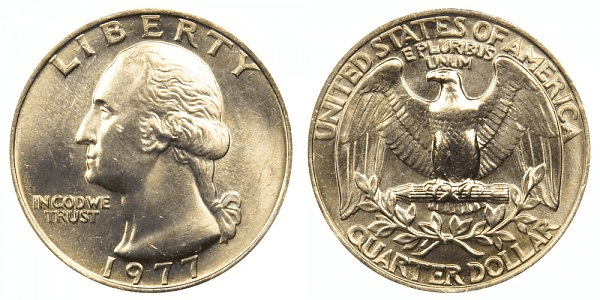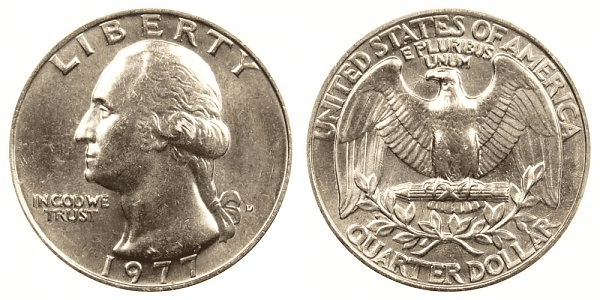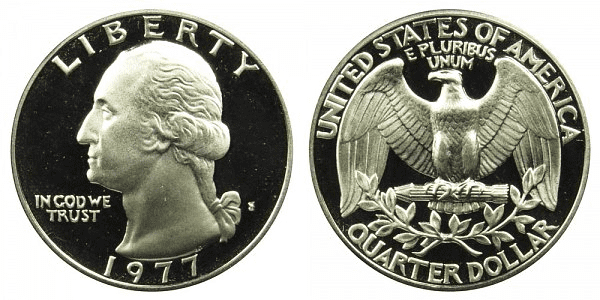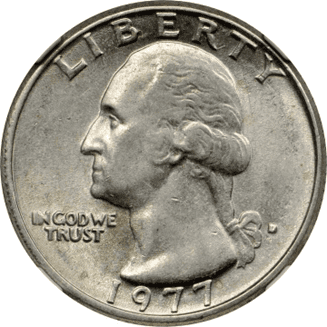What Is A 1977 Washington Quarter Made Of?
Starting in 1968, Washington Quarters contain a 91.67% copper core with an 8.33% nickel covering rather than the older coins’ silver composition. John Flanagan used the 1786 bust of Jean-Antoine Houdon as his basis to produce the depiction of George Washington facing left on the coin’s obverse.
Along with covering Washington’s hair, the phrase “LIBERTY” is etched around the coin’s obverse. Around the bottom of the shorter George Washington bust, the year “1977” is carved. The national motto, “IN GOD WE TRUST,” is located to the left of Washington.
The back of the coin features an Art Deco-inspired heraldic eagle perched on a cluster of arrows. Both the eagle’s head and the arrows point to the left. The eagle’s base is surrounded by two sprays of olive branches arranged in the shape of a U, and the words “United States of America” are printed all the way around the top of the coin.
The motto E PLURIBUS UNUM appears below it. The term “QUARTER DOLLAR” is printed on the coin’s base. The 1977 Washington quarter has a reeded edge.
1977 saw the release of the first Star Wars movie as well as the first Apple II computers being released for sale. Concord had its first commercial flight, and singer Elvis Presley died at the age of 42.
How To Differentiate Between Clad And Silver 1977 Quarters?
All 1977 quarters were supposed to be made of a clad composition. However, there are a few instances of the 1977-D quarter being mistakenly struck in silver. These coins are very rare and sought after, so it’s always worth checking if your coin could be a rare error example.
Coins made of silver are heavier than those made of copper when it comes to weight. Using Washington quarters as a specific example, silver quarters weigh 6.25 grammes, while clad quarters weigh 5.7 grammes. Both have different ageing processes on their exteriors. Over time, silver coins frequently tarnish, whereas clad coins develop a copper tint. When two coins are dropped, they both make a different sound. Non-silver coins sound more like a dull thud while silver coins have a higher pitched sound and ring to them.
1977 Quarter Varieties
1977 P Quarter (No Mint Mark)
Year: 1977
Face Value: $0.25
Composition: 91.67% Copper and 8.33% Nickel
Weight: 5.67g
Diameter: 24.3 mm
Thickness: 1.95 mm
Edge: Reeded
Mint in: Philadelphia
Mint Quantity: 468,556,000

1977 D Quarter
Year: 1977
Face Value: $0.25
Composition: 91.67% Copper and 8.33% Nickel
Weight: 5.67g
Diameter: 24.3 mm
Thickness: 1.95 mm
Edge: Reeded
Mint in: Denver
Mint Quantity: 256,524,978

1977 S Quarter
Year: 1977
Face Value: $0.25
Composition: 91.67% Copper and 8.33% Nickel
Weight: 5.67g
Diameter: 24.3 mm
Thickness: 1.95 mm
Edge: Reeded
Mint in: San Francisco
Mint Quantity: 3,251,152

List of errors
1977-D Struck on Silver-Clad Planchet

Some of the 1776–1976 Bicentennial quarters were created at the San Francisco Mint in a unique 40% silver format for collectors when they were struck. The Denver Mint accidentally struck certain quarters with a date of 1977 on 40% silver blanks meant specifically for the 1976 quarters after processing some of these silver planchets.
The value of these extremely rare 1977-D silver quarter errors is in the hundreds or thousands. One that Numismatic Guaranty Company rated EF40 in 2016 sold for a staggering $4,935
1977 Doubled Die Quarter Error
Doubled dies are a rare sort of mistake variant that was produced by a die that was imprinted with two variations of the same picture. Generally speaking, obscure doubled dies are valued less than extreme ones (like the 1955 doubled die penny). Major doubled dies for 1977 quarters are not known to exist, but tiny ones can be worth anywhere from $25 to $50.
1977 Off-Center Quarter Error
The fact that a portion of the design is missing on both sides of the coin is one of the most distinguishing features of an off-center mistake. In general, a coin needs to have at least 2% or 3% of the design missing in order to qualify as an off-center mistake. An off-center inaccuracy on a 1977 quarter that reveals 10% or 20% of the design is gone can be worth $25 or more.
The 1977 off-center mistake quarters with the most value are those with roughly 50% of their design still visible but with no date. A quarter with such an off-center inaccuracy can sell for $150 to $250 or perhaps more.
1977 Broadstrike Quarter Error
Find a 1977 quarter that is 24.3 millimetrs in diameter and has no ridges or lines on the edge. The coin most likely has no damage and is worth 25 cents face value due to severe wear from frequent usage in vending machines and other sorts of circulation.
The coin may be a broad strike error, though, if it has smooth edges and appears a little wider and thinner than usual. Typically, a 1977 broad strike quarter is worth $20.
How Much Is A 1977 Quarter Worth Today?
The low $0.052 melt value of a 1977 quarter demonstrates that any value (beyond the face value) ascribed to this money comes from considerations such as condition, flaws, and provenance. This coin has no melt value because precious metal isn’t present. With the exception of MS-grade coins, which are only worth their face value since they are still in circulation, the major value of these coins, except rarities, is determined by their condition.
Uncirculated 1977 quarters without a mintmark that are in perfect condition may be worth a little bit more. A 1977 uncirculated quarter typically sells for between $1 and $5. In a 2021 sale, the highest valued 1977 no mintmark quarter, graded MS67+ by Professional Coin Grading Service, brought in $2,550.
An uncirculated 1977-D quarter that has never been used as currency is typically worth $1 to $5. In a 2007 auction, the most valuable 1977-D quarter, graded MS67 by Professional Coin Grading Service, brought $431.
Although certain 1977-S quarters are worth more, the majority are between $2 to $5. At an auction in 2006, the highest valued 1977-S quarter, graded PR70DCAM by Professional Coin Grading Service, sold for $575.
How Does The Grading System Work?
The Sheldon Scale is used by numismatists to provide a numerical value to coins. The Sheldon Scale goes from poor (P-1) to perfect mint state (P-1) (MS-70). Coins were originally evaluated using words to reflect their condition (Good, Fair, Excellent, Etc.). Unfortunately, coin collectors and dealers had different ideas about what each of these terms represent.
Professional numismatists joined together in the 1970s and established CoinGrading standards. These numismatists now assign grades at key places on the seventy-point scale, using the most regularly utilized numeric points in conjunction with the original adjective grade. The following are the most common coin grades:
-
-
- (P-1) Poor – Indistinguishable and probably damaged; if used, must have a date and mintmark; otherwise, rather battered.
- (FR-2) Fair – Nearly smooth, but without the damage that a coin graded Poor often possesses. The coin must have enough detail to be identified.
- (G-4) Fair – Inscriptions have merged into the rims in some areas, and important elements have been mostly erased.
- (VG-8) Very Good- A little weathered, but all of the primary design elements are visible, albeit faintly. There is little if any, central detail left.
- (F-12) Good – The item is very worn, yet the wear is even, and the overall design details stand out clearly. Rims are almost completely isolated from the field.
- (VF-20) Very Fine – Moderately weathered, with some finer features still visible. The motto or all letters of LIBERTY are readable. Both sides of the coin have entire rims that are separated from the field.
- (EF-40) Extremely Fine – Gently used; all gadgets are visible, and the most important ones are bold. The finer details are bold and clear, however, light wear may be seen.
- (AU-50) Uncirculated – Slight evidence of wear on the coin’s design’s high points; may have contact marks; eye appeal should be adequate.
- (AU-58) Uncirculated Choice – Slight traces of wear, no severe contact marks, almost full mint shine, and great eye appeal.
- (MS-60) Mint State Basal – Strictly uncirculated; no indication of wear on the coin’s highest points, but an unsightly coin with reduced luster, visible contact marks, hairlines, and other flaws.
- (MS-63) Mint State Acceptable – Uncirculated, but with contact scratches and nicks, little reduced shine, but otherwise appealing appearance. The strike is weak to average.
- (MS-65) Mint State Choice – Uncirculated with great mint shine, very little contact blemishes, and exceptional eye appeal. The strike is unusually severe.
- (MS-68) Mint State Premium Quality – Uncirculated with superb luster, no obvious contact marks to the naked eye, and exceptional eye appeal. The strike is quick and appealing.
- (MS-69) Almost Perfect Mint State – Uncirculated with perfect brilliance, a sharp and appealing strike, and extremely good eye appeal. A near-perfect coin with minor imperfections in the planchet, strike, and contact markings (seen only under 8x magnification).
- (MS-70) Mint State Perfect – Under 8x magnification, there are no tiny imperfections discernible; the strike is crisp, and the coin is perfectly centered on a beautiful planchet. Rarely seen on a coin, this coin is bright and whole, with original luster and exceptional eye appeal.
-
Where To Buy Or Sell 1977 Quarters?
If you have a 1977 quarter in your collection, it can be beneficial to carefully inspect it to look for any faults or identifying features before you think about selling. There are a number of 1977 quarters to be on the lookout for, including those that are mentioned above and the incredibly rare silver coin error.
Regular 1977 quarters are valued for their novelty and sentimental worth and can be purchased or sold for a few bucks on online marketplaces like Etsy and eBay.
If you’re unsure but believe you might have something rare, you can post an image to a forum for coin collectors to seek assistance.
You may prevent fraud while purchasing and selling rare 1977 quarters by only doing business with reputable, specialised dealers like Heritage Auctions.
FAQs
What is a 1977 spitting eagle quarter?
On the reverse, a die clash—a raised line produced when two dies come into contact without a planchet—near the mouth of the eagle helps identify this mistake variant. It looks like the eagle is spitting because of where it is. Several mint years have been attributed to this error, but there have been no recorded examples of 1977 quarters displaying this issue.
What is a rare error on a 1977 quarter?
The rarest error to look for in a 1977 quarter is a coin that has been struck on a silver planchet.
Does a 1977 quarter have a mint mark?
Yes, the mint mark on a 1977 quarter can be found to the right of Washington’s ponytail.
How much is a 1977 Canadian quarter worth?
1977 Canadian Quarters are worth around their face value.
